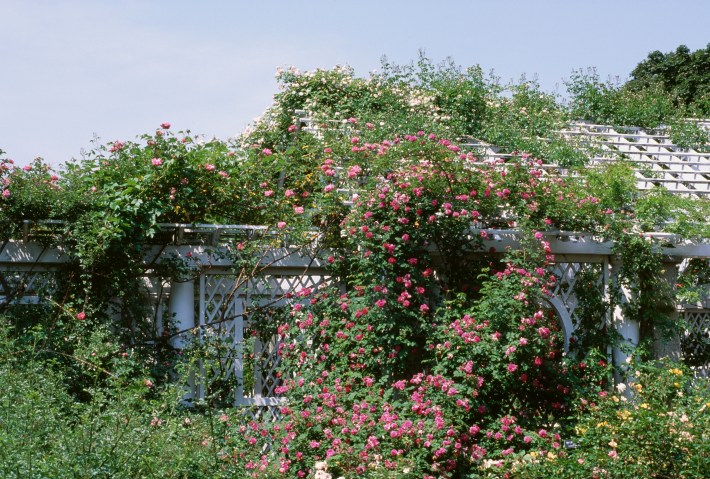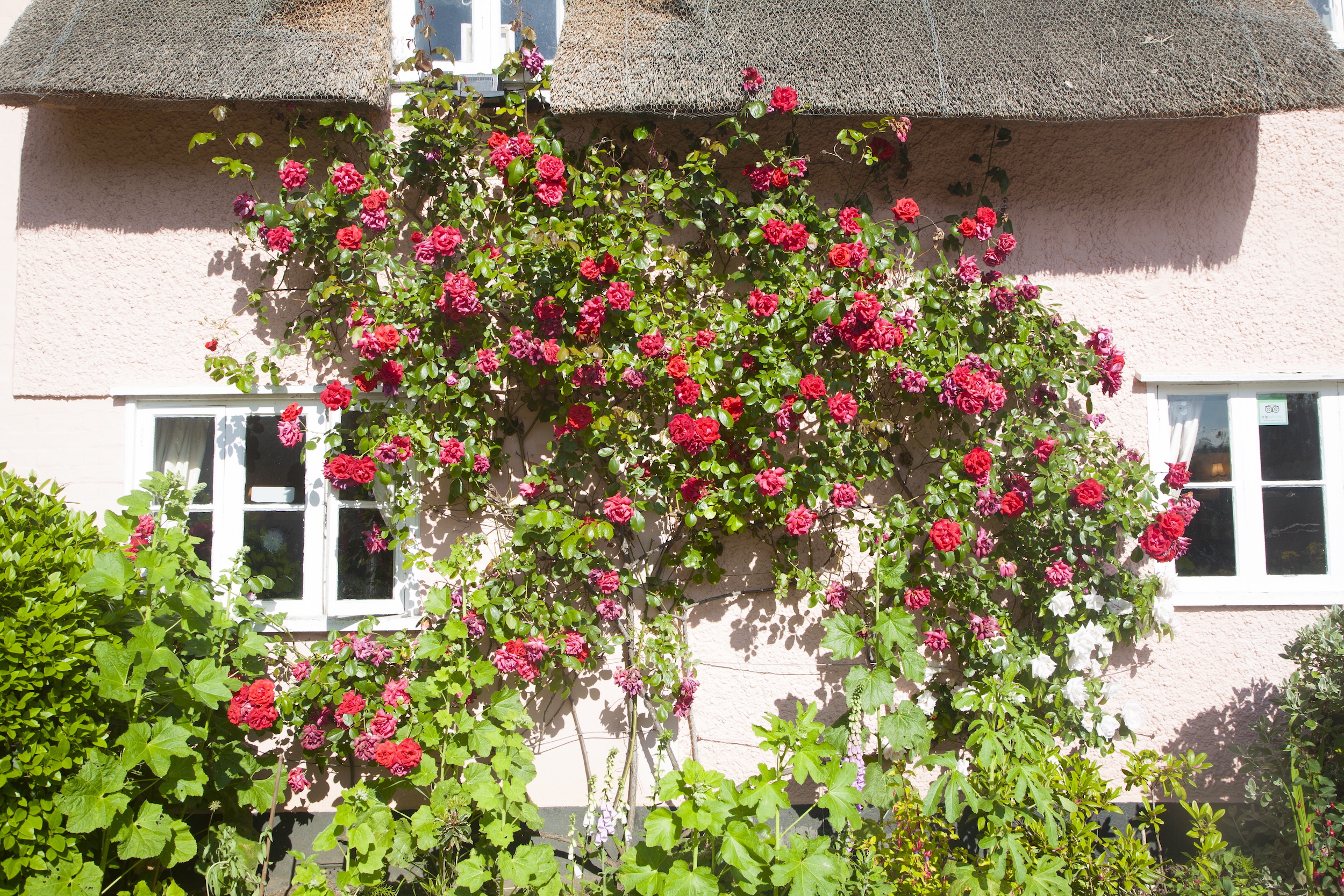There is geometry to the successful growing of climbing roses. It's not a very exotic formula, but for one whose climbing rose journey begins with the simple and sweetly naive idea that it would be lovely to walk under an archway of roses, to pass daily or even hourly through an invisible veil of rose scent as though through a boundary of gauze and to emerge on the other side transformed by the experience, and then to repeat that transformation again and again until you yourself begin to emit a calming aura of tea and myrrh, and then the knowledge that there are roses that will climb up over your head and form such a passage, that you too can have this beauty in your life merely by making space for these intrepid cultivars in a couple square feet of dirt, eventually learning that there are angles to this business can be disconcerting, in particular if that bit of information comes after you have already planted the damned things.
The proper angle is 45 degrees, or something close to that. I said it was not exotic. At 45 degrees, the main canes of a climbing rose will produce the greatest number of lateral canes, and it is from these lateral canes—also best maintained at something close to a 45-degree angle—that buds will grow and become blossoms. What the fuck is a cane. Rosarians—this is a word that means "people who cultivate roses"—use the word "cane" to mean "trunk" or "stem" or "stalk." Rosarians have their own language. A climbing rose's main canes come directly from the base of the plant. In an own-root rose that means they grow smoothly from the plant's root clump. What the fuck is an own-root rose. An own-root rose is a rose that grows from its own roots. You would think that any rose that grows from its own roots would be called a Rose, and that any rose that grows from roots that are not its own roots would be called, I don't know, an Other-Root Rose. Not so. For you see, many of the more aesthetically pleasing and thus popular roses are less hardy to environmental conditions found away from their natural range, and are therefore commonly grafted onto the roots of hardier roses. Grafted roses are so common that a rosarian would think nothing of assuming that a given rose has been grafted, and may even be surprised to learn that he or she is in fact in the presence of an own-root rose.
What was I talking about. Canes. Main canes come from the base of the plant. A large bulge at bud union can help to identify a grafted rose, and although no particular prestige is granted one way or another, this information is useful because it is important that your rose is planted deep enough that the bud union is buried several inches beneath the surface. What the fuck is a bud union. Bud union is the place where the delicate upper plant was grafted onto the hardy lower one. Did you already plant your rose, and now you are looking at it and wondering whether it was wrong of you to leave that large round belly resting out in the open? Whether your rose might feel somewhat less self-conscious if that paunch were hidden beneath several inches of soil? Was it this curiosity that brought you to a blog on the internet, where you encountered words like "cane" and "own-root" and "bud union" and began to get the queasy feeling that you could not simply put this beautiful thing into the dirt and love it distantly but sincerely, and otherwise trust it to take over from there? Buddy, my friend, my good chum: Bud union is the least of it. Simply dig up your rose, now, before its delicate little roots spread and make this exhumation any more fraught an operation than it already is, and bury it four to five inches deeper than you did the first time.
This is a good time to discuss fish heads. One thing that will greatly benefit your rose over the early stages of its journey upward, and then forever after, is nitrogen, potassium, and phosphorus. Actually those are three things. Nitrogen encourages leaf growth, which is good because leaves are how plants do photosynthesis, which I am told is uhh pretty much all that plants do. Potassium is important for flowering, which is the entirety of everything else that plants do. Phosphorus helps with root growth. You could always just plant your rose in whatever virgin soil God gave you—you boob, you neophyte, you total and absolute clod for all time—and then periodically feed it from above with fertilizer, carefully watering the fertilizer into the soil so that it is dispersed evenly among the roots all the way to the bottom. The trouble there is it can be very challenging to get the right nutrient ratios, especially as manufacturers make and market extravagantly nutrient-rich fertilizers in order to gain an edge on the shelves of your local garden store. The consequences for overdoing it can be severe. Too much nitrogen can burn the roots. Too much phosphorus can cause a condition where the plant is unable to produce enough chlorophyll, which is the pigment that plants use to convert sunlight into energy.
Are you—the poor innocent sucker who thought, "Roses that climb, neat," and brought home a rose plant for the bitchin' blossoms and only hours later discovered he'd begun a complicated long-term relationship with a beautiful, vulnerable living thing that will without too much warning up and fucking die from mistreatment—prepared to compute milliliters? Being honest with yourself: Are you quite up to this? To neither starving nor overfeeding this poor thing that cannot speak for itself except by withering? Remember the bud union: You screwed that up already. Also nutrient-heavy fertilizers are bad for the world. You could murder your plant through care and also murder a watershed in the bargain.
There is another way. Before returning the rose to the soil, simply throw the severed head of a fish into the bottom of the dirt well. This sounds like something done to appease a pagan deity. Fish heads have nitrogen and phosphorus and potassium, not to mention calcium and magnesium and assorted other nutrients. This grisly pre-planting ritual will time-release these valuable nutrients into the soil as the fish head decays, and the roots of your rose will reach down to find them, and by so doing become deep and strong. Deep roots are more virtuous than shallow ones, certainly, or powerful people would not boast of having them in places where they have chosen no longer to live.
If you get the planting part right—and, frankly, even if you do not get it right, because your poor rose will gamely attempt to thrive for a while even if you plant it in a paint can full of sand—there will come a day when the main canes explode upward and become so verdant that the structure looks almost shaggy with fresh new foliage. This is a happy day. Then over the next several days the rose will continue exploding, but into several different directions. This will be the time that you realize that this thing is making decisions for itself and that you do not necessarily agree with all of them. Also the canes are now so robustly enfoliaged that you can no longer easily tell which are the main canes and which are the lateral canes. Why is this a thing you should know. Main canes are precious and must never be pruned; Lateral canes are fungible and renewable and in certain cases ornamental, and must and shall be pruned. Wait a minute, no one said anything about pruning. Christ what have I gotten myself into.
In any case too many of the canes appear to be bending toward the sun in a tangled race. The most precocious of them are even flopping over with the new weight of slim green bud heads. This rose is supposed to be progressing along an arbor trellis toward an arch-like structure, or neatly and in two convenient dimensions against the surface of a wall or fence, or otherwise in a more-or-less upward direction, only now it appears to want to go sideways. Why is it like this. Does it not realize the grand visions you have for its future, if it would simply adhere to your expectations.
This is when I am afraid you must learn at last that a "climbing rose" does not climb in any recognizable sense of the word. Honeysuckle climbs. Whenever honeysuckle leans against something firm its slender green stems—where climbing roses have canes, climbing vines are content with stems—become woody and fibrous, stiffening the plant. Thus fortified, the honeysuckle inches upward, sending more of itself in search of higher scaffolding. Whenever it outgrows this structure or finds that there is nothing left to lean against, it sends its nutrients to some other part of itself, in search of some other structure against which to climb, and abandons that portion of itself that reached for the sky and found only air. Clematis climbs by sending out adorable little paired leaflets; when those leaflets encounter something reasonably twig-like, they gently but firmly coil around it, and the stem thickens, and at its head another pair of teeny little leaflets spring into existence, searching for another rung. The point is that there are plants that know how to climb, and that your climbing rose is not one of them.
Your climbing rose certainly will become long, and certainly it will prefer to become long in the direction of sunlight. But without training it will tend to become long haphazardly, up and then out and then over and then down, without the slightest natural gift or handy mechanism for finding support or hoisting its bulk vertically. In its native environment—the wilds of south and east Asia—your climbing rose would figure this out for itself, and be fine. It is only because someone once observed that certain roses will become long, and under the most advantageous of circumstances will become long vertically, and then called them "climbing roses" in a language which happens to be your very own, and then centuries later that fateful marketing maneuver caused you to purchase one of them and imagine yourself eventually standing beneath it, happily, that you are in this predicament, needing to convince a thorny yet delicate imported bramble to please behave according to what lifestyle magazines seem to indicate is a mutually desirable condition of existence.

You imagined you would stand back and watch as your climbing rose grew strong and found the convenient swirls of your trellis and followed them into a graceful arched configuration. Instead it is becoming an expanding tangled chaos of painful thorns, low and mean and hostile to even the best intentions. There is nothing else for it: You will have to intercede. Instead of loving your climbing rose from afar, you will have to get down in there, and you will have to wear thick heavy gloves when you do so. You will need a sturdy pair of bypass pruners and some zipper ties or twist ties or twine. Also you will be at this intercession project for a period of years. If you are very lucky, possibly even decades.
The good news is, you can and should wait to attack your rose with blades until the weather turns cool and your rose goes dormant and drops its foliage. This will mean standing there helplessly and refusing to intervene even while it appears that your rose is using the growing season to undermine its own future. Yes, this will be agony. Autumn will bring the right conditions for big-picture guidance. The clearer view will make it easier to sense what ideas your rose has already had—which canes are healthiest and sturdiest, which ones are pointed in a stupid direction and might benefit from redirection, which ones are overlapped and superfluous and should be snipped—so that you can meld its sense of itself with your preference for it to adopt a particular orientation. Keep a few sturdy main canes, or perhaps all of them. Select and save a lateral cane or two per main cane, choosing ones that can be teased out into the desired shape. Remind yourself periodically of the important angle at which the canes of your rose will be the most productive, an approximately equidistant compromise between vertical (the direction that will most immediately fill the wall or trellis for which the rose was intended) and horizontal (the direction it will grow if left to its own stupid impulses).
Later, a few summers from now, after getting this wrong a few times and then right, and then right again a few times in succession, you will snip a perfect yellow rose from a tall plant with thick woody main canes and lovely long meandering lateral canes, shaped by a mutual exchange of ideas and encouragements. Perhaps you will be deadheading when inspiration strikes. What the fuck is deadheading. Deadheading is when you clip spent blossoms from your rose. This gentle upkeep is done regularly during the growing season, because a rose looks nicer without a bunch of gnarly brown spent roses all over the place, but also because prompt deadheading, especially of flowering clusters, strengthens the canes and encourages more flowering. You will snip a perfect rose and you will tuck the little length of stem into your shirt pocket so that the blossom perches there on your chest, and you will spend the next few hours inhaling and emitting tea and myrrh. Yes, you could also just buy some roses. Screw you, that's not the point.






